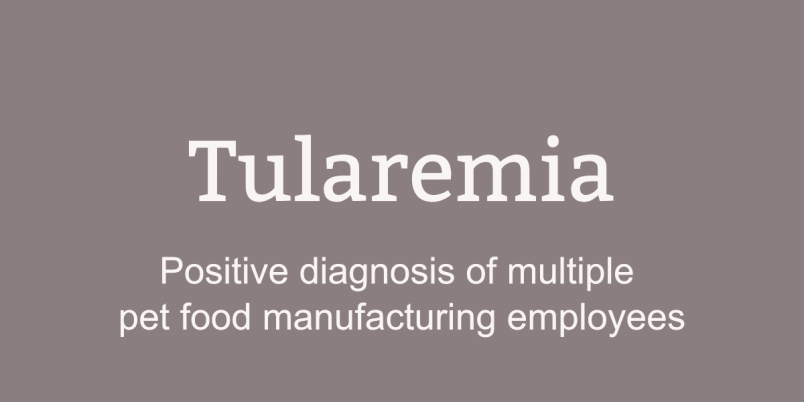If you or a family member/friend works at or lives near a kibble manufacturing plant or a rendering facility and you have experienced any of these health conditions – difficulty breathing, cough, muscle aches, abdominal pains – please contact me.
I have been alerted to a potential human health risk for employees of kibble manufacturing or rendering facilities and potentially to family members of these employees. This is a attempt to informally survey employees or family members and as well informally survey residents within a 1 mile radius of kibble manufacturing or a rendering facility.
Background: Multiple employees of kibble manufacturing have been diagnosed with tularemia. The disease is most commonly believed to be spread by ticks who have previously bitten an infected animal. However, from the Centers for Disease Control “Humans can acquire tularemia by inhaling dust or aerosols contaminated with F. tularensis bacteria. This can occur during farming or landscaping activities, especially when machinery (e.g. tractors or mowers) runs over infected animals or carcasses. Although rare, this type of exposure can result in pneumonic tularemia, one of the most severe forms of the disease.”
It is suspected that these pet food manufacturing employees obtained the disease from breathing ‘dust’ of meat meal ingredients in the pet food, each had no other potential exposure risk.
Tularemia is a ‘reportable disease’ – meaning doctors are required to report positive results to local health officials (Health Department) who in turn reports the disease to the Centers for Disease Control.
There are two problems…
One: Tularemia is not easily recognized and diagnosed. The individuals that I have spoken with who were diagnosed went through a barrage of other testing – some for months – when doctors finally tested for tularemia. They felt it was just “luck” for doctors to find the cause of their illness.
Two: Centers for Disease Control have not investigated the potential link of meat meal pet food ingredients that are allowed by FDA to contain diseased/non-slaughtered animals – of significant risk to spread the disease.
Thus this informal survey.
Symptoms of tularemia include…
- Difficulty breathing, cough
- Muscle pain, aches
- Some can have elevated white blood cell counts
- Abdominal pain
- Some have lumps raise across the chest, back, neck and head
If you or anyone you know that has worked at a kibble pet food manufacturing plant and/or a rendering facility, lived near or worked near the same and you have had the above symptoms, please share your story with me. Symptoms can come and go or remain consistent. Left untreated, this illness can be deadly.
If you or anyone you know that has worked at a kibble pet food manufacturing plant and/or a rendering facility, lived near or worked near the same and you have been diagnosed with tularemia, please share your story with me.
Please use the contact form on this website to reach me. All identities will remain anonymous, but overall results of this informal survey will be shared with Centers for Disease Control.
Again, we have confirmed cases of tularemia of multiple employees of kibble pet food manufacturing. This is not to say with certainty these individuals obtained the disease from exposure to contaminated ingredients at the pet food plant – it is only suspected. This informal survey is an attempt to gather more information in an effort to try to urge officials to investigate the issue fully.
As a side note – cats and dogs can as well become ill from tularemia. It is most commonly believed the disease is spread to pets from either a tick bite or consuming a contaminated dead wild animal (such as a rabbit). With the confirmation of pet food manufacturing employees contracting tularemia, I have to wonder if the disease could also be spread through pet food. At this point in time, we do not know if that risk exists.
To learn more about tularemia in dogs, Click Here.
To learn more about tularemia in cats, Click Here.
To learn more about tularemia in humans, Click Here.
Wishing you and your pet(s) the best,
Susan Thixton
Pet Food Safety Advocate
Author Buyer Beware, Co-Author Dinner PAWsible
TruthaboutPetFood.com
Association for Truth in Pet Food
What’s in Your Pet’s Food?
Is your dog or cat eating risk ingredients? Chinese imports? Petsumer Report tells the ‘rest of the story’ on over 5,000 cat foods, dog foods, and pet treats. 30 Day Satisfaction Guarantee. Click Here to preview Petsumer Report. www.PetsumerReport.com

The 2017 List
Susan’s List of trusted pet foods. Click Here
Have you read Buyer Beware? Click Here
Cooking pet food made easy, Dinner PAWsible
Find Healthy Pet Foods in Your Area Click Here



























T Allen
October 18, 2017 at 4:08 pm
Wow. Tularemia is rare. Usually a disease of hunters (that’s why it’s much more prevalent in men) in contact with wild animals while skinning them. Check this out: https://www.cdc.gov/mmwr/preview/mmwrhtml/mm6247a5.htm#fig1. Wonder why MO & AR are such a hotbed of cases? Hope these people get the medical attention they need!
marklucas522
October 27, 2017 at 9:36 am
Didn’t know this type of issue existed. So sad! Why isn’t this issue talked about more? Although I don’t live near one of these plants, it certainly is good to know. Thanks for sharing!
eathealthydoggy.com
Laura
December 23, 2017 at 9:58 am
We are going to find out that it is NOT rare at all. Hauling diseased tissue into a kibble plant is happening and not only are we killing or making our precious pets so sick, we are now going to understand what it is doing to employees of these plants. It is time that pet owners understand what is going on.